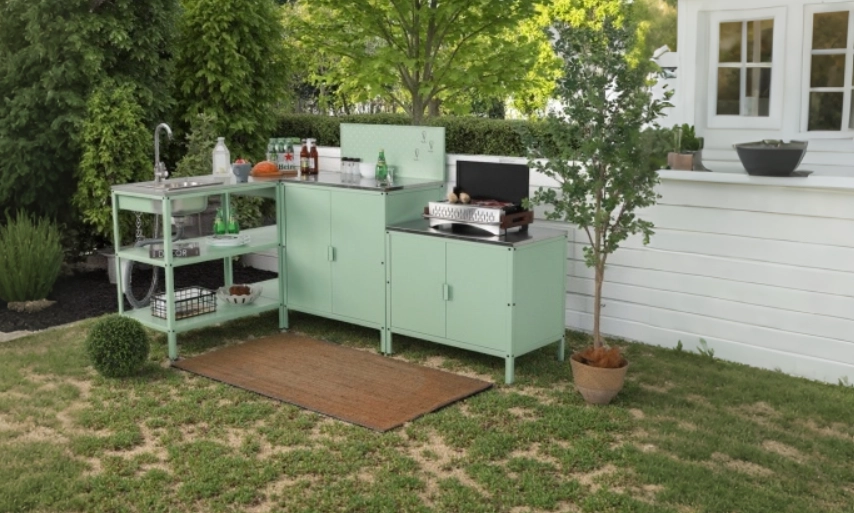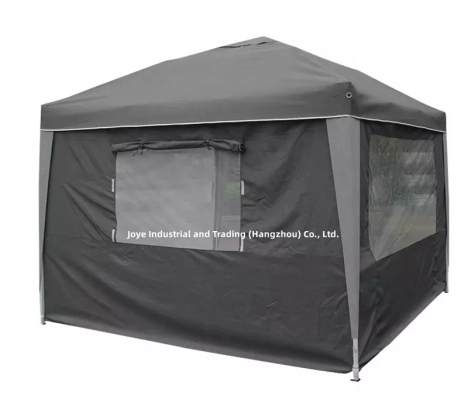What Makes a Gazebo Stronger in Coastal or Windy Places
Outdoor spaces are no longer just “extra.” In many markets, from beach towns to windy plains, people want gazebos that do more than provide shade—they want them to survive rough weather and still look good. Importers know the risk: a gazebo that bends, rusts, or rips apart after one season is a fast way to lose repeat buyers. That’s why strength matters. With over two decades in outdoor furniture manufacturing, JoyeLeisure has seen what works, what fails, and what makes a gazebo reliable in harsh conditions.

Why Does Location Matter for Gazebo Strength
Where the product ends up decides how long it will last. A gazebo that holds fine in a calm inland garden might collapse in a seaside café after just one storm.
Effects of salty air and coastal humidity
Salt is sneaky—it eats away at untreated metals faster than most buyers expect. Hinges, screws, even the powder coating can bubble if not done right. A seaside gazebo needs frames that resist corrosion and coatings that don’t peel.
Impact of constant wind exposure
Wind is unforgiving. Cheap structures rattle, bend, or simply take off. Stronger models use thicker frames and reinforced joints to absorb the push. Resorts have lost thousands of flimsy tents after one typhoon season, while heavy-duty gazebos stood almost untouched.
Seasonal extremes in temperature and rainfall
Gazebos in coastal or tropical areas don’t just fight wind—they face heavy rains and blazing sun. Fabrics that aren’t UV-stable fade within months, and untreated seams start leaking. For importers, checking the specs against the local climate is a must.
What Materials Make a Gazebo More Durable
The heart of durability lies in the materials chosen.
Powder-coated steel or aluminum frames
Steel has weight and strength, but it must be protected. Powder coating forms a tougher shield than paint and resists chipping. Aluminum, on the other hand, is lighter and naturally rust-resistant. Aluminum is often recommended for use in coastal areas because it handles salty air better.
High-density polyester or PVC-coated fabrics
Fabric isn’t just about color—it’s the skin of the gazebo. A high-density polyester with PVC backing won’t sag after a heavy rain. Add UV inhibitors, and the colors stay rich even after 2,000 hours of sun.
Reinforced joints and rust-resistant fasteners
A gazebo is only as strong as its weakest joint. Stainless steel fasteners and well-designed brackets keep the whole structure from wobbling. Importers who cut corners here often regret it after customer complaints roll in.
How Does Design Influence Stability in Windy Areas
Material strength is one thing, but design is the second half of the equation.
Cross-beam and truss reinforcements
A simple frame won’t do in high winds. Cross-beams distribute stress and reduce sway. Truss structures, though slightly heavier, bring real stability.
Adjustable anchoring and weighted bases
Buyers sometimes overlook anchoring, but in windy zones, it’s vital. Adjustable anchors allow secure setups on concrete, grass, or sand. Weighted base plates add that extra safety without complicating installation.
Side walls and wind panels as protective features
Side walls don’t just block sun or provide privacy—they cut wind flow. JoyeLeisure’s models with detachable side panels help reduce strain on the main canopy and give customers flexible use.
Which Testing and Certifications Should Importers Look For
Numbers and certificates matter when selling in professional markets.
Wind resistance ratings and lab tests
Some gazebos undergo wind tunnel testing, proving they can stand at certain speeds. A model rated for Beaufort scale 7 (near gale) gives buyers confidence.
Fabric UV resistance and waterproof ratings
Good suppliers will share lab reports showing UPF ratings for UV resistance and hydrostatic head tests for waterproofing. These aren’t just technical details—they’re proof the gazebo won’t fail in six months.
Compliance with international safety standards
For B2B shipments into Europe or the US, certifications like CE and ISO 9001 smooth customs checks and reassure retailers about product quality.
How Can Importers Balance Strength and Portability
A strong gazebo shouldn’t mean it takes a team of ten to move it. Balance is key.
Foldable vs fixed-frame gazebos
Fixed frames are sturdier, but folding gazebos travel better. Importers should match the product to the target market—event rental companies might want foldable, while hotels prefer fixed.
Weight-to-strength considerations
Sometimes extra weight adds strength, but too much makes logistics costly. Smart use of aluminum or steel alloys keeps shipping practical without sacrificing safety.
Modular designs for easy replacement
Instead of replacing a full gazebo after one part fails, modular systems let buyers swap panels or poles. This reduces waste and keeps customers happy.
What Products Stand Out in Coastal and Windy Markets
JoyeLeisure’s catalog shows how thoughtful design meets tough environments.
Madrid 3x3m Full Steel Garden Gazebo
Madrid 3x3m Full Steel Garden Gazebo comes with reinforced steel frames and a weatherproof canopy. It’s built for resorts, beach cafés, and events where reliability matters. The frame has thicker poles than standard models, and the surface treatment helps resist both rust and peeling. Importers targeting coastal markets often pick this one because it combines strength with visual appeal.
3x3m Easy Pop-up Gazebo with Side Walls
Speed matters too. For markets that need fast setup—like event rentals or weekend fairs—the 3x3m pop-up gazebo is ideal. It folds down compactly but, thanks to reinforced joints and optional side walls, handles wind far better than the average pop-up. The side walls add not just shade but protection from crosswinds, making it versatile for both inland and seaside use.

OEM/ODM options for local requirements
Beyond off-the-shelf models, JoyeLeisure offers customization. Importers dealing with storm-prone zones might request heavier frames or special anchoring kits. Those selling into sunny Mediterranean resorts might prioritize UV-blocking fabrics in lighter shades. Flexibility is the advantage of working with a manufacturer, not just a reseller.
How to Provide Long-Term Value for Buyers
Durability isn’t only about the product—it’s also about support.
Offering spare parts and maintenance kits
Spare canopy fabric, extra fasteners, or a repair kit packed with the shipment can extend a gazebo’s lifespan significantly. Importers who include these find customers return with compliments instead of complaints.
Clear assembly instructions and support
Nobody enjoys a confusing manual. Good suppliers send step-by-step guides or short videos. Warehouses save time, retailers get fewer returns, and end-users feel confident.
Long-term partnerships with reliable suppliers
Strength isn’t only in steel and fabric—it’s in the relationship. Importers who stick with suppliers like JoyeLeisure often get faster lead times, better customization options, and reliable after-sales service.
FAQ
Q1: What wind speed can a strong gazebo handle?
A: Heavy-duty models with reinforced frames can handle winds up to Beaufort scale 7–8, depending on anchoring.
Q2: Can I order custom sizes for different markets?
A: Absolutely. OEM/ODM options allow different dimensions, frame thicknesses, and fabrics based on local demand.
Q3: How can importers reduce shipping costs without sacrificing strength?
A: Look for foldable or modular designs. They pack tighter, cutting freight costs, but still deliver durability when set up.




